General Hospitals
These were large base hospitals with 250, 500 or 1000 beds. They also generally administered a number of auxiliary hospitals. The 1st, 2nd, 3rd, 10th and 14th served overseas; the others were based in Australia. The 1st, 2nd, 3rd and 14th were all eventually upgraded to the maximum size.
1st Australian General Hospital (1AGH) Formed Queensland, August 1914. Departed Brisbane aboard Kyarra 21 November 1914. (Egypt, Western Front)
1AGH Egypt This hospital was located in various buildings in Cairo. It dealt with all war cases—physical injuries, diseases, shell shock.
1AGH Rouen, France This hospital dealt with general battle casualties.
2nd Australian General Hospital (2AGH) Formed New South Wales August 1914. Departed Sydney aboard Kyarra 28 November 1914. (Egypt, Western Front)
2AGH Boulogne, France This was a large tented hospital, and most of the patients were battle casualties. It came to specialise in the treatment of fractures. This hospital experienced many air raids. Towards the end of the war there were outbreaks of influenza. When the armistice was signed, the staff barely found time to celebrate. They were too busy treating the influenza victims who continued to arrive throughout November.
3rd Australian General Hospital (3AGH) Formed New South Wales 1915. Departed Sydney aboard Mooltan 5 May 1915. (England, Gallipoli, Egypt, Western Front)
3AGH Abbeville, France This hospital operated from tents and huts at Abbeville, in the Somme area of France. For most of its existence (May 1917 to May 1918) it admitted gassed patients and treated them briefly before sending them to other places.
10th General Hospital Formed July 1915. Departed Australia 22 July 1915. Arrived in the United Kingdom 29 September 1915. This unit was intended as a 500 bed general hospital for the treatment of Australians in the United Kingdom, but owing to a lack of accommodation and poor AIF medical administration, it was broken up at Harefield, England in October 1915 and personnel used to staff Auxiliary Hospitals. (England)
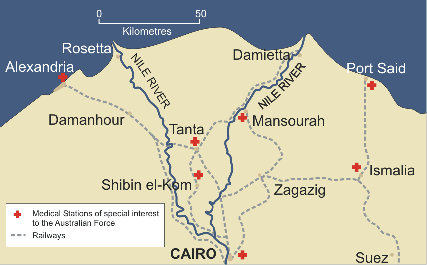
The maps above and below depict the area where the AIF trained before going to Gallipoli. The medical facilities were necessary to support the troops while in training and later, after deployment to Gallipoli.
14th General Hospital Formed 1916. Departed Melbourne 19 August 1916. Was located at Abbassia, Cairo. (Egypt)
Auxiliary Hospitals These were located in rear areas. Generally they were administered by a general hospital (AGH). They had no fixed establishments.
1st Australian Auxiliary Hospital (1AAH) Opened 19 January 1915 at Luna Park, Cairo, Egypt. Closed 10 July 1916. Opened 1916 at Harefield, England. Closed 31 December 1918. This hospital contained over 1000 beds for casualties from France. Mostly they were surgical cases and it was possible for special attention to be given to amputees before their return to Australia.
2nd Australian Auxiliary Hospital (2AAH) This hospital located at Southall, England, specialised in the fitting of artificial limbs.
3rd Australian Auxiliary Hospital (3AAH) This hospital, located in Dartford, England, grew to 1400 beds and was for the treatment of war-related nerves and neuroses.
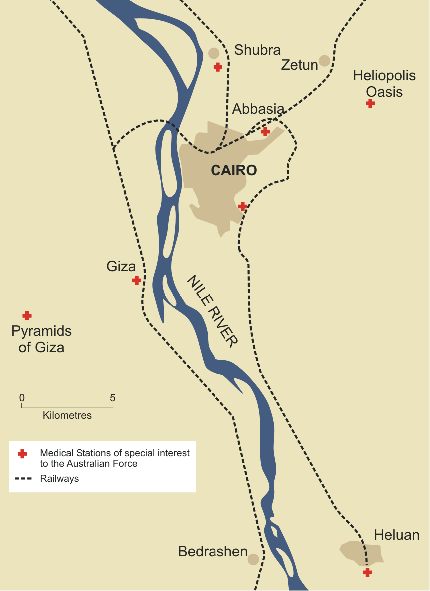
Click to view a large map of medical facilities in the UK and France (new window).
Stationary Hospitals
These were smaller hospitals, generally based in forward areas.
Casualty Clearing Stations
These were small hospitals, generally located at a railhead or similar transportation hub in forward areas. Their job was to provide emergency treatment and to move casualties back to the stationary and general hospitals.
Convalescent and Command Depots
Convalescent or Command Depots were half way houses for casualties returning to the front — men who no longer required hospitalisation but were not yet fit to rejoin their units. They also were known as ‘Convalescent Homes’.
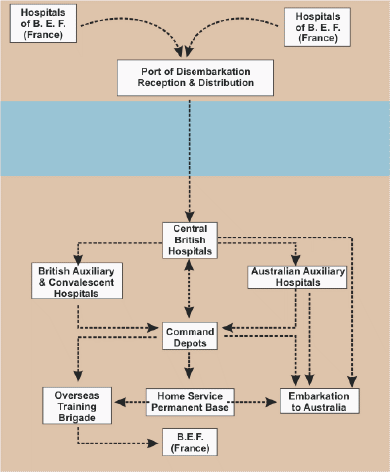
This diagram depicts the theoretical distribution and disposal of Australian sick and wounded arriving in the UK. Diagram courtesy Robert Lewis.
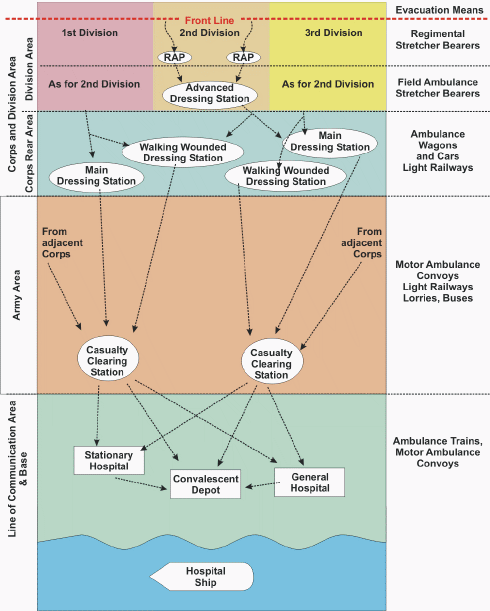
This diagram of the system of evacuation shows the theoretical location of medical facilities for the Allies during WW1. While the evacuation system followed this general plan, in practice medical facilities were placed where they could best carry out their tasks under the exigencies of the operational situation. RAP = Regimental Aid Post (the unit-level medical support facility, eg in a battalion). Diagram courtesy Robert Lewis.
For more information on the WW1 hospitals and medical facilities visit:http://www.unsw.adfa.edu.au/~rmallett/ then select Part B - Branches Medical.
Additional images for these stories
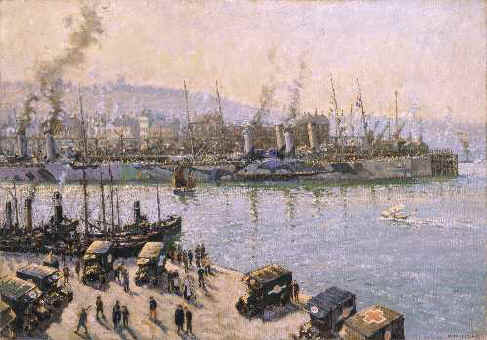
Like to copy this image? Please click here first
AWM ART03612. Charles Bryant, Boulogne in wartime, January 1918, 1923, Painting: oil on canvas, 73.7 x 104.5 cm. Boulogne, France. In the foreground are ambulances which would have transported wounded from the Front to the hospital ships for transfer to hospitals in England.
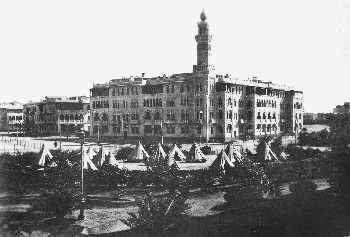
Like to copy this image? Please click here first
AWM P00037.020. Heliopolis, Egypt. c. 1916. Elevated view of approximately fifteen tents in the grounds of Heliopolis Palace occupied by 1st Australian General Hospital (1AGH). The tents were erected all around the grounds as space inside the building became scarce. They are dwarfed by a multistorey building across the street from the gardens.
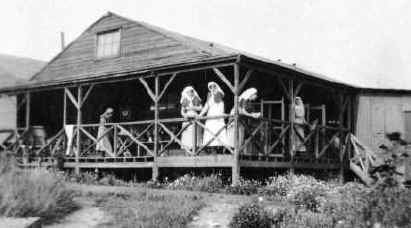
Like to copy this image? Please click here first
AWM P02402.022. Wimereux, France. c. 1917. Front exterior of the sisters’ quarters of the 2nd Australian General Hospital (2AGH).
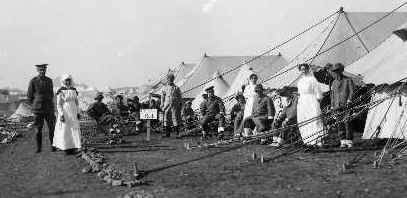
Like to copy this image? Please click here first
AWM J01438. Lemnos Island, Greece, 1915. Medical and nursing staff of 3rd Australian General Hospital in the tent lines with patients.

Like to copy this image? Please click here first
AWM E02117A. The wards and outbuildings of the 2nd Australian General Hospital (2AGH). 2AGH was a large hospital which had expanded from 520 beds to 1900. The beds were housed in hundreds of huts and tents.
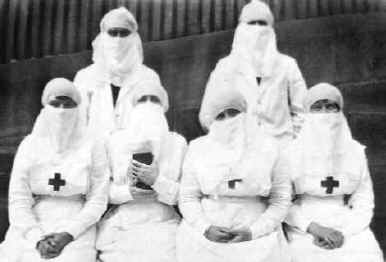
Like to copy this image? Please click here first
AWM P01102.021. Australian Red Cross Voluntary Aid detachment members in uniform and wearing protective clothing for nursing influenza victims.
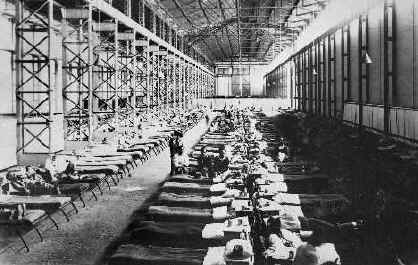
Like to copy this image? Please click here first
AWM P00812.020. Port Said, c. 1917. Wounded and sick Australians in an enormous hospital ward, possibly set up in a warehouse.
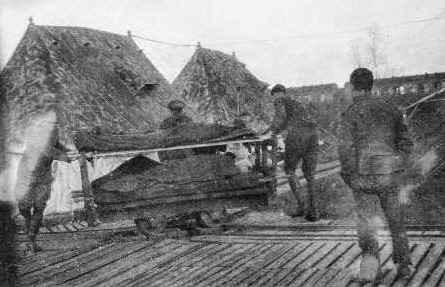
Like to copy this image? Please click here first
AWM P00156.061. Medical orderlies at the 2nd Australian Casualty Clearing Station near Steenwerck moving patients over duckboard walkways (to avoid the muddy ground) using a two-tiered stretcher holder on wheels. The stretcher holder could run along railway tracks leading to the train (seen in the background), which pulled up right at the camp. Here the orderlies are changing direction at a turntable.
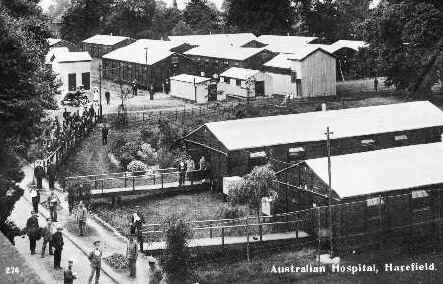
Like to copy this image? Please click here first
AWM P00162.020. Harefield, Middlesex, England, 1914-18. 1st Australian Auxiliary Hospital.
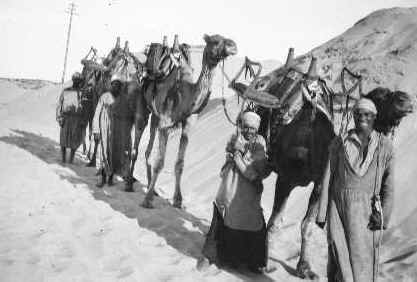
Like to copy this image? Please click here first
AWM J00914. Camel cacolets used by the Light Horse Field Ambulance used for bringing sick and wounded across the desert to the clearing stations, from where they are sent to base hospitals.
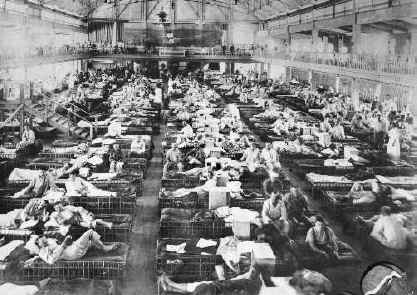
Like to copy this image? Please click here first
AWM H18510. Heliopolis, Egypt. c. 1915. The interior of the Auxiliary Hospital which formed part of 1st Australian General Hospital (1AGH), located in the former Heliopolis Palace Hotel. The inmates were from Gallipoli.





